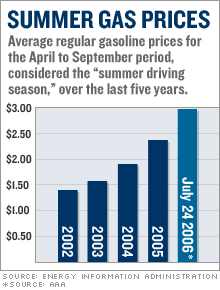|
Holiday 2006: Hostage to gas prices A slow start to back-to-school retail sales could signal consumers will be less gung-ho about Christmas shopping this year. NEW YORK (CNNMoney.com) -- As gasoline prices continue to flirt with new record highs, they're also having a chilling effect on consumers' ability and inclination to shop for the latest fads like a pair of Gap's blue-black skinny jeans. Where's the proof?
Marshal Cohen, chief industry analyst with market research firm NPD Group, said he sees it in the slow start to back-to-school shopping. An NPD survey of 34,000 consumers released Monday showed people were not only delaying stocking up for school season but they also plan to spend about the same amount of money as they did in 2005. "In the last three years, back-to-school has been a clear indicator of what's going to happen during the holidays," Cohen said. "Consumers are throttling back their shopping later and later." Gas prices are one factor dampening shopping enthusiasm. The other is lack of must-have merchandise, Cohen said. "Retailers and brands aren't doing enough to excite consumers to shop for back-to-school. Unfortunately, I'm hearing the same rumblings about holiday 2006," said Cohen. "Unless something different materializes in the next two months to drive the buying momentum, I think we will see slow and steady holiday sales growth." Slow and steady isn't necessarily a bad thing, Cohen clarified. Holiday sales could grow between 3 percent and 3.5 percent this year. "That's still a decent number but not as robust as last year," he said. A holiday full of surprises Retailers' fourth quarter, and specifically November to December combined, are the industry's most crucial sales period. Those two months alone can account for as much as 50 percent of merchants' annual revenue and profits. Holiday sales last year grew a strong 6.4 percent to $438.6 billion, according to the National Retail Federation (NRF), the industry's largest trade group. The NRF hasn't yet released its holiday sales forecast. Scott Krugman, spokesman for the NRF, said he agrees with the NPD's survey that lots of back-to-school shopping will happen in August, a little later than usual. At the same time, the NRF expects families will still dig deep and spend more - not less - than they did last year on school-related products. The group estimates total spending to reach $17.6 billion, up from $13.4 billion in 2005. "You can't discount the consumer just yet," Krugman said. Even so, the NRF itself has tempered sales expectations for the second half of the year. The group anticipates third-quarter sales to increase 5.5 percent and 4.6 percent for the fourth quarter. That compares with an 8.8 percent and 8.4 percent increase in the first and second quarters. "The first half of the year was very, very strong. So that sets up a difficult comparison for retailers. Last year we forecast holiday sales to grow 6 percent and they came in stronger than that. So the holiday season can surprise us," Krugman said. But are consumers running out of gas? Some industry watchers are fearful that consumers are feeling both economically and emotionally tapped out. Wendy Liebmann, president of retail consulting firm WSL Strategic Retail, cited a May survey of 1,500 consumers that she said revealed some "mind-boggling numbers." "Two things jumped out," said Liebmann."The first was 57 percent of people said they're driving less because of gas. And 50 percent said they're cutting back on clothing, electronics, magazines and beauty products. That's one in two people who are changing the way they live and shop." "The everyday impact of the roller coaster of gas prices is the more tangible aspect of the economy," Liebmann said. "I think the holiday season will be tough this year. Some people just won't be able to spend more." The emotional effect, or what she calls the "Carpe Diem" impact, could possibly help to offset the gas woes. "It's a very odd American phenomenon, which we also saw after Sept. 11," she said. "With everything going on politically in the world, some people will think they should spend on themselves and their family because they don't know what tomorrow could look like." Who's hot, who's not Among retailers who are apt to grab shoppers' holiday dollars, NPD's Cohen likes department-store chains J.C. Penney (Charts) and Kohl's (Charts). "Their merchandise, price points and customer service should appeal to consumers," he said. Discounters like Target (Charts) and Wal-Mart (Charts) should fare well over back-to-school and the holidays in certain categories but maybe not in overall sales. "Target will be strong in apparel sales," he said. "Wal-Mart will grow sales in consumables as low and-mid-income consumers trade down in prices to adjust their budget for higher gas prices." But even as people trade down in products and prices, they're also making fewer trips to stores. That's a risk to Wal-Mart as well as Target, which lowered its July sales outlook last week. Liebmann said sales at luxury sellers such as Nordstrom (Charts) and Coach (Charts) should hold strong through the holidays because their high-income shoppers are unaffected by the vagaries of gas prices. Luxury merchants' fortunes are tied more to the stock market's performance, she said. |
|


